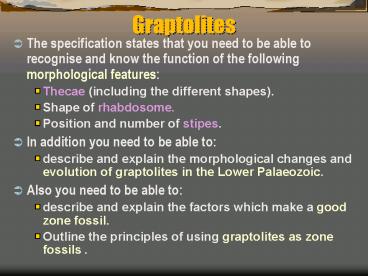Graptolites - PowerPoint PPT Presentation
1 / 11
Title:
Graptolites
Description:
Graptolites. The specification states that you need to be ... side (UNISERIAL) or both sides (BISERIAL) or even four (QUADRISERIAL) giving an X cross section. ... – PowerPoint PPT presentation
Number of Views:2007
Avg rating:3.0/5.0
Title: Graptolites
1
Graptolites
- The specification states that you need to be able
to recognise and know the function of the
following morphological features - Thecae (including the different shapes).
- Shape of rhabdosome.
- Position and number of stipes.
- In addition you need to be able to
- describe and explain the morphological changes
and evolution of graptolites in the Lower
Palaeozoic. - Also you need to be able to
- describe and explain the factors which make a
good zone fossil. - Outline the principles of using graptolites as
zone fossils .
2
Graptolites Classification
- Phylum
- Hemichordata.
- Class
- Graptolithina
- Orders
- Graptoloidea
- Dendroidea
3
INTRODUCTION
- The exoskeleton is made of organic protein
material secreted by the soft parts of the
animal. - Both orders consisted of small animals, which
were mainly pelagic (planktonic) living in
colonies. - The one skeleton is actually a colony containing
several soft-bodied animals (zooids) which could
extend out of the cups.
4
GRAPTOLOIDEA (GRAPTOLITES)
- Found in Palaeozoic rocks only (middle Cambrian
to the Carboniferous). - They are pelagic and planktonic.
- Graptolites are most commonly found in deep water
black shales, but do extend into shallow
conditions. - They are nearly always carbonised.
- The process of carbonisation combined with the
highly compressible nature of shales made most
graptolite fossils extremely flat and therefore
difficult to study. - They are useful zone fossils.
5
Zone Fossils
- What is a zone fossil?
- A fossil species characteristic of a certain rock
horizon and is restricted to this time span e.g.
certain Monograptus, ammonites, goniatites and
ceratites. Micraster... - What features make a good zone fossil?
- Abundant.
- Short lived (evolved rapidly).
- Easily Identifiable.
- Widespread Geographically.
- Hard parts.
- Graptolites did evolve quickly between L.
Ordovician and U. Silurian and the planktonic
mode of life allowed them to be widely
distributed.
6
MORPHOLOGY
- ? The colony originates as a single conical cup
SICULA and from this the colony develops. - Consist of hollow tubes (STIPES) single or
multiple. - THECAE are small cups joined together, which
house the zooids (which are joined together by a
common nervous system).
7
MORPHOLOGY 2
- THECAE form as overlapping cups along the
length of the skeleton (STIPE). - These may be present on one side (UNISERIAL) or
both sides (BISERIAL) or even four (QUADRISERIAL)
giving an X cross section. - The colony can contain a varying number of
stipes commonly 1, 2, 4, 8 etc.
8
Thecal shape variation
9
Stipe Attitude
- There is a particular terminology used in order
to describe the attitude of the stipes.
10
Graptolite Morphological Terms
11
COMMON GENERA TO KNOW
- Didymograptus
- Look at page 211 Draw.
- Diplograptus
- Look at page 211 Draw.
- Monograptus
- Look at page 211 Draw.































